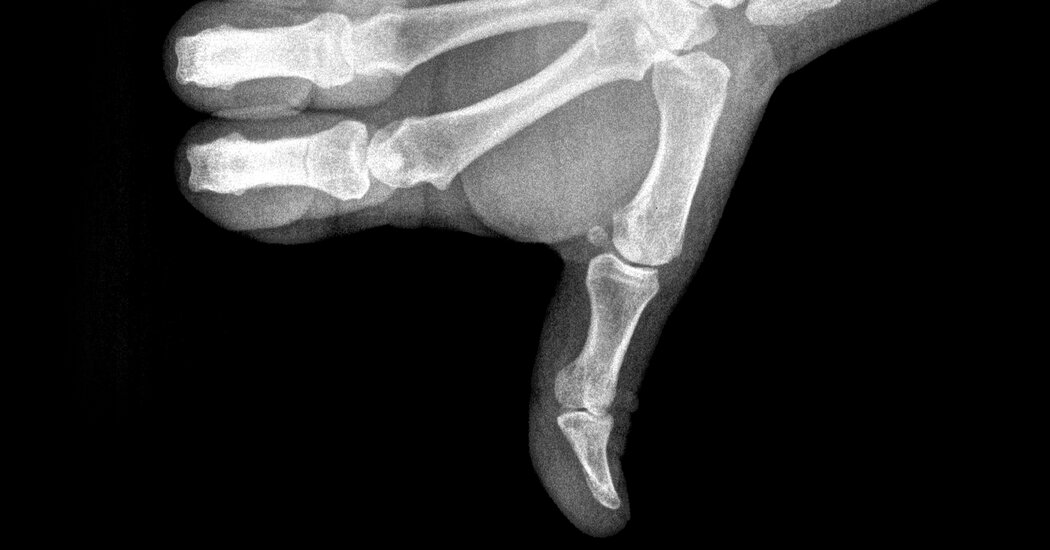Thank goodness for urgent care centers. Last July my daughter was still limping a week after a bike injury, and we needed a quick X-ray to rule out a fracture. As a doctor, I knew we didn’t need an expensive emergency room for something this straightforward. We found an urgent care at the end of a strip mall in Chicago, and 20 minutes later we received the good news that there was only a sprain.
As the three employees closed up shop for the day, I reflected on how urgent-care centers filled a perfect niche between the overkill of an emergency room and the near impossibility of snagging an immediate orthopedic appointment.
But this is health care in America, and nothing ever closes up tidily. Two weeks later a bill arrived: The radiology charge from NorthShore University HealthSystem for the ankle and wrist X-rays was $1,168, a price that seemed way out of range for something that usually costs around $100 for each X-ray. When I examined the bill more closely, I saw that the radiology portion came not from the urgent care center but from a hospital, so we were billed for hospital-based X-rays. When I inquired about the bill, I was told that the center was hospital-affiliated and as such, is allowed to charge hospital prices.
It turns out that I’d stumbled into a lucrative corner of the health care market called hospital outpatient departments, or HOPDs. They do some of the same outpatient care — colonoscopies, X-rays, medication injections — just as doctors’ offices and clinics do. But because they are considered part of a hospital, they get to charge hospital-level prices for these outpatient procedures, even though the patients aren’t as sick as inpatients. Since these facilities don’t necessarily look like hospitals, patients can be easily deceived and end up with hefty financial surprises. I’m a doctor who works in a hospital every day, and I was fooled.
As of 2022, federal law protects patients from surprise bills if they are unknowingly treated by out-of-network doctors. But there is no federal protection for patients who are unknowingly treated in higher-priced hospital affiliates that look like normal doctors’ offices or urgent care clinics. Federal regulations are needed, at the very least, to require facilities to be upfront with their pricing scheme — and more ideally, to eliminate this price differential entirely. Otherwise patients will continue to face unexpected high bills that most can ill afford.
One study of pricing revealed that HOPDs charged an average of $1,383 for a colonoscopy, compared with the $625 average price at a doctor’s office or other non-HOPD settings. A knee M.R.I. averaged $900, compared with $600. Chemotherapy and other medications cost twice as much. Echocardiograms command up to three times as much. Much of these costs comes from tacked-on facility fees, which are rising far faster than other medical costs.
The American Hospital Association justifies these costs by arguing that patients seen in HOPDs are sicker than other outpatients. But that doesn’t typically make the procedures performed at these facilities any more complicated; an outpatient echocardiogram, for instance, is basically the same no matter who it’s for. If a patient’s illness does render a procedure more complicated, there are legitimate ways to account and bill for that.
Last December the health insurer Blue Cross Blue Shield released findings that HOPDs charged far more than doctors’ offices for certain procedures. (Prostate biopsies, for example, cost over six times as much.) HOPDs turn out to be an attractive business plan for hospitals that are aggressively acquiring doctors’ practices. When these acquisitions occur, prices often rise as patients are now seen in “hospital facilities.”
It’s difficult to quantify how many patients find themselves unknowingly getting higher-price care at HOPDs as we did. But news outlets have reported frustrations suffered by some patients receiving hospital-cost charges after a visit to walk-in care centers. There are also stories on Reddit and other platforms about new — and steep — facility fees at doctors’ offices appearing on medical bills and often not covered by insurance. One patient’s bill went up 10-fold for the same procedure after her doctor’s practice changed its classification of her appointment to a hospital-based designation. Another study of outpatient surgical procedures found an increase of more than 50 percent in facility fees over the course of six years, resulting in much higher out-of-pocket expenses for patients. Most patients find out only weeks later when the bill arrives.
There’s a movement afoot to make so-called site-neutral payments the law, meaning that Medicare would pay doctors the same price for an outpatient procedure like an endoscopy, no matter what type of outpatient setting it’s performed in. Though at least 16 states have passed laws requiring transparency about facility fees, headwinds are still stiff. Congress inserted a site-neutral payment rule into the Bipartisan Budget Act of 2015, but ferocious lobbying from the hospital industry exempted nearly all existing HOPDs. The American Hospital Association vehemently opposes any legislation that equalizes HOPD payments or eliminates facility fees.
The House recently passed the Lower Costs, More Transparency Act, which would enforce site-neutral payments for one narrow slice of health care — physician-administered medications. The Senate has yet to take up any such legislation.
I was so livid about being charged hospital rates for two simple X-rays that I filed a formal complaint with the Illinois attorney general’s office, which concluded that the billing was legal under federal law. When I asked for on-the-record comments about my contention that the charges seemed excessive and that the system felt deceptive, a representative for NorthShore University HealthSystem (now Endeavor Health) offered only a general statement that read, in part: “We understand that navigating the health care landscape, including billing, can be complex.”
It’s time for Congress to protect patients from both unfair pricing schemes and health care deception. MedPAC, the nonpartisan Medicare Payment Advisory Commission, recently recommended to Congress a basic set of site-neutral policies. It would apply site-neutral payments to a handful of low-risk procedures — some imaging, medication injections, simple office procedures — and this would apply to all HOPDs.
After six months of fighting the cost, the hospital quietly canceled our bill. I’m sure it calculated that this was the simplest way to get rid of a pesky patient — but that wasn’t what I was after. I wanted to untangle this loophole that catches patients unaware and saddles them with exorbitant bills. Congress should tune out hospital lobbying and enact these common-sense measures to protect patients.
Danielle Ofri, a primary care doctor at Bellevue Hospital, is the author of “When We Do Harm: A Doctor Confronts Medical Error.”
Source photograph by Chase D’animulls, via Getty Images.
The Times is committed to publishing a diversity of letters to the editor. We’d like to hear what you think about this or any of our articles. Here are some tips. And here’s our email: letters@nytimes.com.
Follow the New York Times Opinion section on Facebook, Instagram, TikTok, WhatsApp, X and Threads.



